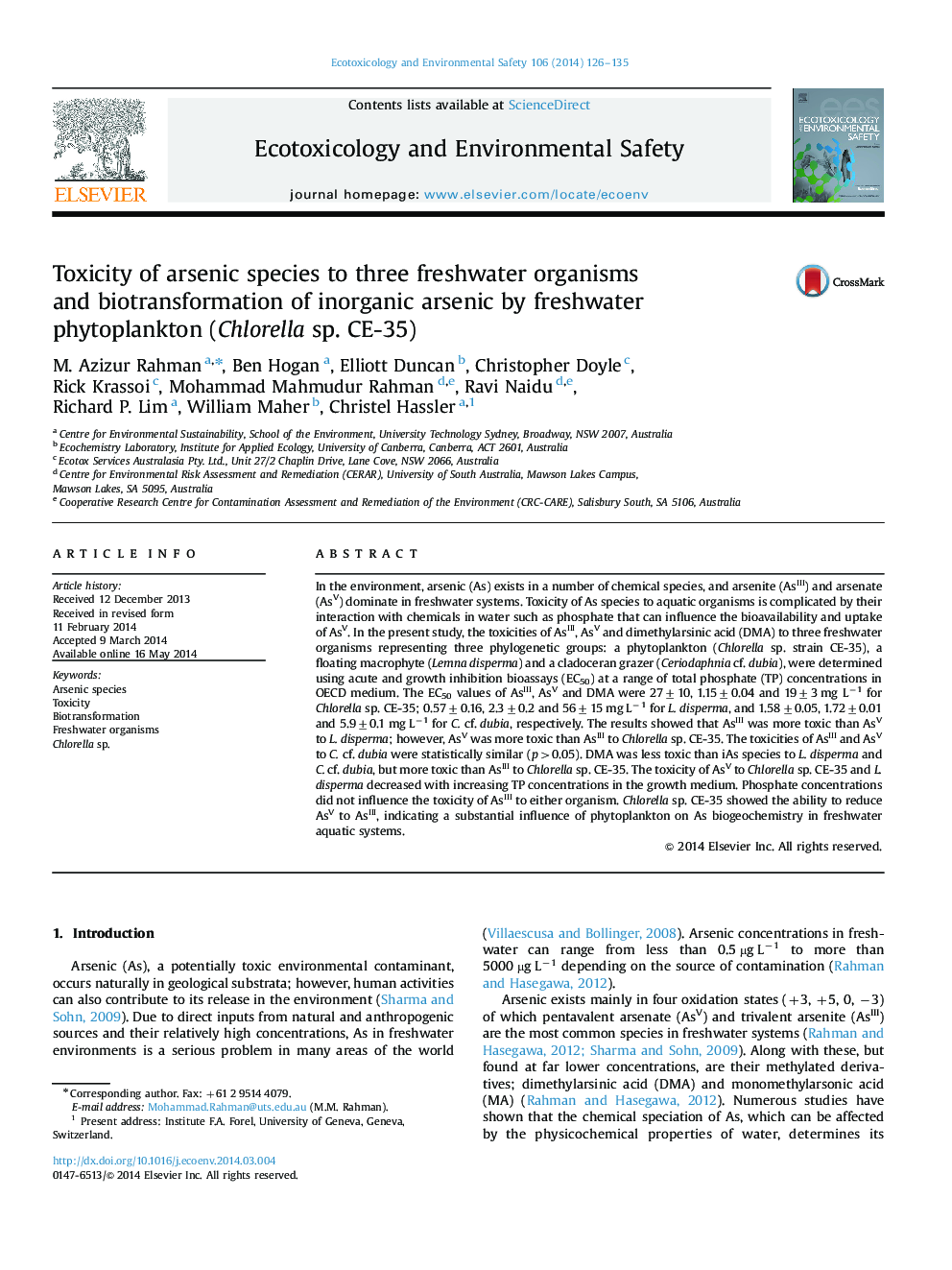| کد مقاله | کد نشریه | سال انتشار | مقاله انگلیسی | نسخه تمام متن |
|---|---|---|---|---|
| 4420023 | 1618957 | 2014 | 10 صفحه PDF | دانلود رایگان |

• AsIII was more toxic than AsV to L. disperma, while the opposite was for Chlorella sp. CE-35.
• AsIII and AsV showed similar toxicity to cladoceran grazer (Ceriodaphnia cf. dubia).
• DMA was less toxic than AsIII and AsV to L. disperma and C. cf. dubia, but more toxic than AsIII to Chlorella sp. CE-35.
• Phosphate concentrations have significant influence on AsV toxicity to all the three organisms.
In the environment, arsenic (As) exists in a number of chemical species, and arsenite (AsIII) and arsenate (AsV) dominate in freshwater systems. Toxicity of As species to aquatic organisms is complicated by their interaction with chemicals in water such as phosphate that can influence the bioavailability and uptake of AsV. In the present study, the toxicities of AsIII, AsV and dimethylarsinic acid (DMA) to three freshwater organisms representing three phylogenetic groups: a phytoplankton (Chlorella sp. strain CE-35), a floating macrophyte (Lemna disperma) and a cladoceran grazer (Ceriodaphnia cf. dubia), were determined using acute and growth inhibition bioassays (EC50) at a range of total phosphate (TP) concentrations in OECD medium. The EC50 values of AsIII, AsV and DMA were 27±10, 1.15±0.04 and 19±3 mg L−1 for Chlorella sp. CE-35; 0.57±0.16, 2.3±0.2 and 56±15 mg L−1 for L. disperma, and 1.58±0.05, 1.72±0.01 and 5.9±0.1 mg L−1 for C. cf. dubia, respectively. The results showed that AsIII was more toxic than AsV to L. disperma; however, AsV was more toxic than AsIII to Chlorella sp. CE-35. The toxicities of AsIII and AsV to C. cf. dubia were statistically similar (p>0.05). DMA was less toxic than iAs species to L. disperma and C. cf. dubia, but more toxic than AsIII to Chlorella sp. CE-35. The toxicity of AsV to Chlorella sp. CE-35 and L. disperma decreased with increasing TP concentrations in the growth medium. Phosphate concentrations did not influence the toxicity of AsIII to either organism. Chlorella sp. CE-35 showed the ability to reduce AsV to AsIII, indicating a substantial influence of phytoplankton on As biogeochemistry in freshwater aquatic systems.
Biotransformation of As species by phytoplankton: (A) Arsenate (AsO43−AsO43−) competes with phosphate (PO43−PO43−) for uptake transporters in the cell membrane. Phytoplankton actively takes up AsO43−AsO43− under low phosphate condition because they mistake it for PO43−PO43−. Arsenate is then reduced to AsIII and subsequently biotransformed to DMA, MMA and complex organoarsenic compounds before excretion into the water. (B) Uptake and biotransformation of AsV by phytoplankton as influenced by phosphate concentrations in the medium. Arrows indicate the PO43−PO43− concentrations in the medium (thick and thin arrows are for low and high phosphate concentrations, respectively).Figure optionsDownload as PowerPoint slide
Journal: Ecotoxicology and Environmental Safety - Volume 106, August 2014, Pages 126–135